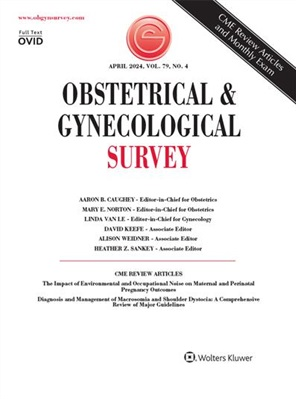108349名荷兰孕妇的无细胞DNA病毒组
IF 3.6
4区 医学
Q1 OBSTETRICS & GYNECOLOGY
引用次数: 0
摘要
怀孕增加了身体对传染病的易感性,目前的怀孕指南包括尽量减少可能的病毒感染。在确实发生病毒感染的情况下,这些可能会导致母亲和胎儿出现轻微到严重的并发症;许多导致这种并发症的病毒是DNA病毒。目前的DNA病毒诊断技术主要依赖于聚合酶链反应(PCR),该技术非常敏感,但通常针对特定的病毒,因此往往不是很全面。此外,这种检测通常只对那些有高风险或有症状的人进行。为了更充分地了解DNA病毒在怀孕期间的影响和流行程度,本研究使用了无细胞DNA (cfDNA)的无创产前检测(NIPT)来检测2017年至2020年间孕妇的DNA病毒组。数据包括108,349人的NIPT鉴定结果,DNA序列用于筛选224种DNA病毒。通过精细决策树的分类方法,对基因相似的病毒进行分类,避免了分类的泛化错误。最常检测到的病毒是细小病毒B19,大约在3000个cfDNA读数中出现1个。乙型肝炎病毒、bocaparvov病毒、乳头瘤病毒、腺病毒、腺相关病毒、eb病毒/疱疹病毒4、巨细胞病毒(CMV)、疱疹病毒6和torque teno病毒的病毒载量也很高。人口统计学和妊娠因素的交叉检查揭示了许多关联,其中大多数在多次比较调整后仍然显着。可用的特征包括母亲年龄、体重指数(BMI)、胎龄、胎儿分数以及样本中存在病毒DNA的测序读数。病毒DNA的检测与较低的BMI、较低的cfDNA浓度和较高的胎儿分数相关。当对单个病毒进行分析时,巨细胞病毒与胎龄和母亲年龄的关系最为显著。结果还表明,低胎儿分数与特定病毒的低病毒DNA检测相关。这些结果表明,在NIPT样品中检测病毒DNA是可行的。如果能检测到病毒DNA,就有可能诊断感染,并可能预防由病毒引起的并发症。目前的临床实践并没有使用NIPT作为病毒感染的诊断工具,但在未来有这种潜力。进一步的研究应侧重于临床应用、敏感性、特异性和准确性,以及病毒DNA与低胎儿分数的关系。本文章由计算机程序翻译,如有差异,请以英文原文为准。
The Cell-Free DNA Virome of 108,349 Dutch Pregnant Women
ABSTRACT Pregnancy increases the body's vulnerability to infectious disease, and current guidelines during pregnancy include minimizing possible exposure to viral infection. In cases where viral infection does occur, these can cause mild to severe complications in both mother and fetus; many viruses that result in such complications are DNA viruses. Current diagnosis technology for DNA viruses relies largely on polymerase chain reaction (PCR), which is very sensitive but generally targeted at a specific virus and so tends to not be very comprehensive. In addition, this testing is normally performed only on those who are at high risk or expressing symptoms. To more fully understand the effect and prevalence of DNA viruses in pregnancy, this study used noninvasive prenatal testing (NIPT) that captures cell-free DNA (cfDNA) to examine the DNA virome in pregnant women between 2017 and 2020. Data included deidentified NIPT results for 108,349 individuals, and DNA sequences were used to screen for 224 DNA viruses. Viruses that were genetically similar were differentiated based on taxonomy through a meticulous decision tree to avoid generalized errors in categorizing them. The most commonly detected virus was parvovirus B19, occurring in approximately 1 in 3000 cfDNA reads. High viral loads were also observed for hepatitis B, Bocaparvovirus , papillomavirus, adenovirus, adeno-associated virus, Epstein-Barr virus (EBV)/herpesvirus 4, cytomegalovirus (CMV), herpesvirus 6, and torque teno virus. A cross-examination of demographic and pregnancy factors revealed many associations, most of which remained significant after adjustments for multiple comparisons. Available characteristics included maternal age, body mass index (BMI), gestational age, fetal fraction, and the number of sequenced reads with the presence of viral DNA in the samples. Detection of viral DNA was associated with lower BMI, along with a lower concentration of cfDNA and a higher fetal fraction. When individual viruses were analyzed, CMV had the most significant relationship with gestational age and maternal age. Results additionally showed that low fetal fraction was associated with lower detection of viral DNA for specific viruses. These results show that it is feasible to detect viral DNA in NIPT samples. If viral DNA can be detected, there is potential to diagnose infection and to possibly prevent complications due to the virus. Current clinical practice does not use NIPT as a diagnostic tool for viral infection, but there is potential for this in the future. Further research should focus on clinical utility, sensitivity, specificity, and accuracy, as well as the relationship of viral DNA with low fetal fraction.
求助全文
通过发布文献求助,成功后即可免费获取论文全文。
去求助
来源期刊
CiteScore
2.70
自引率
3.20%
发文量
245
审稿时长
>12 weeks
期刊介绍:
Each monthly issue of Obstetrical & Gynecological Survey presents summaries of the most timely and clinically relevant research being published worldwide. These concise, easy-to-read summaries provide expert insight into how to apply the latest research to patient care. The accompanying editorial commentary puts the studies into perspective and supplies authoritative guidance. The result is a valuable, time-saving resource for busy clinicians.

 求助内容:
求助内容: 应助结果提醒方式:
应助结果提醒方式:


